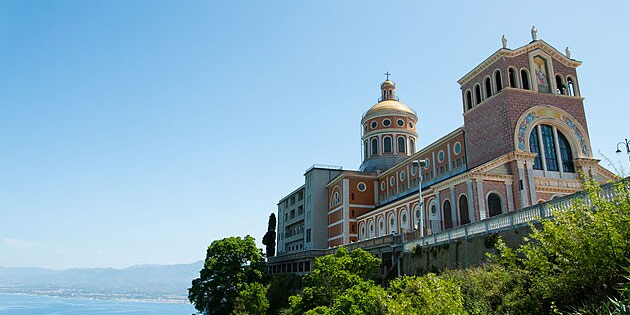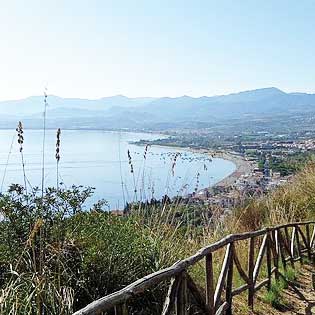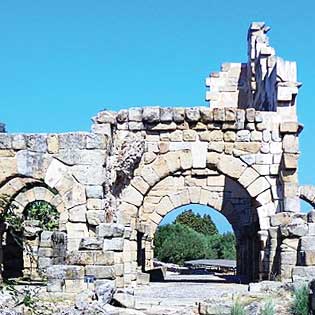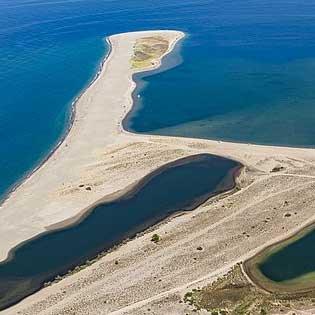Sanctuary Maria Santissima del Tindari
The Basilica Sanctuary of Maria Santissima del Tindari, also known as the Sanctuary of the Black Madonna of Tindari, stands on the top of the Tindari hill and dominates the Marinello lakes.
It is one of the most evocative places of worship in the province of Messina, whose history seems to have its roots in the ancient one of the Greek acropolis of Tyndaris, whose ruins are located in the adjacent Archaeological Area of Tindari. The current building covers the area where the primitive fortress of Tindari once existed, whose existence is documented by the presence of battlements in the pre-existing buildings of worship.
The cult is linked to the wooden statue of the brown Madonna. According to tradition, the statue, which came from the East to escape iconoclastic persecution, prevented the ship carrying it from leaving, after it had taken refuge in the bay of Tindari near the Marinello lakes to escape a storm. The sailors gradually deposited the load on the ground, thinking that this was to prevent the departure, and only they deposited the wooden statue on the ground, the ship was able to resume the sea. This fact was interpreted as the Virgin's desire to remain in that place. The statue was then brought to the hill above, inside a small church which later had to be enlarged several times to accommodate pilgrims, attracted by the miraculous fame of the simulacrum.
Although we refer to the Sanctuary of Tindari, in reality there are two sanctuaries: the ancient one and the modern one. In fact, it was preferred to build a new sanctuary instead of expanding the old one, to preserve the beauty and history of the latter. The history of the ancient sanctuary dates back to the time when Tindari was the seat of the diocese. Between 1552 and 1598, the building was built overlooking the sea and soon became a famous pilgrimage destination. It is believed that the ancient sanctuary was erected on the remains of a primitive temple linked to the cult of Ceres or other divinities, but there is no certain proof in this regard since the assault of the Turkish-Ottoman army of Barbarossa in 1544 destroyed everything. It is known that, over the centuries, the ancient Sanctuary was no longer able to contain the enormous flow of pilgrims who flocked to venerate the Black Madonna, so in 1957, at the behest of Bishop Monsignor Pullano, the new church was built, larger, and adjacent to the ancient one.
The Ancient Sanctuary has a gabled facade inserted between bell towers. The relief of the arch of the portal is made in ashlar together with the surface of the first order of the external wall of the facade. The second order is characterized by a circular window above the entrance. The third order consists of a triangular tympanum with the dedication "Ave Maria". The bell towers are embellished in the lower orders by simple frames, in the central orders by eight-pointed stars, obtained from the superimposition of staggered squares, in the third order, where there is the belfry, by single lancet windows and on the left by a blind oculus it houses the quadrant of the 'clock. The fourth order has cusps with a square base.
The Modern Sanctuary has a facade with the central part consisting of an advanced body that rises on the opposite square facing west, the elevation constitutes the development of the bell tower. The doors are in bronze, on the sides of the central door are placed, in special niches, the statues depicting St. Peter and St. Paul. Access to the sanctuary is guaranteed by an atrium decorated with stained glass windows, where allegorical figures of the cardinal virtues are depicted: Prudence, Justice, Fortitude, Temperance. The theological virtues are reproduced on the access gates: Faith, left entrance, Charity, central passage, Hope, right entrance.
The new sanctuary has a basilical plan, a Latin cross, three naves, with a square transept and a semicircular apse. The base is in Billiemi marble, the slopes of the roof are covered with blue ceramics. On the northern side, adjacent to the left aisle, there is a loggia 76 meters long and 8 meters wide, which allows you to admire the panorama of the Marinello lakes. Under the loggia there is a large room which, connected to the crypt, forms the penitentiary of the sanctuary.
Inside there is the wooden statue of the brown Madonna, a wooden sculpture in cedar from Lebanon , oriental style, datable between the end of the eighth century and the first decades of the ninth century. The Madonna is black, with a characteristic long face not easily found in other religious statues, and is a Theotókos Odigitria represented as Basilissa, that is, as a queen, holding the Baby Jesus in her lap, holding her right hand raised and blessing. On the head is placed a crown or a turban of oriental type. Under the throne, the inscription "Nigra Sum Sed Formosa" takes up the phrase from the Song of Songs 1,5, and literally means "I am black but beautiful". charm, are also the legends that revolve around the cult of the Black Madonna.



